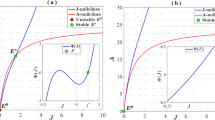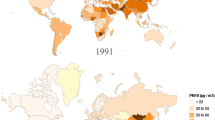Abstract
Temporal variation of airborne bracken (Pteridium aquilinum) spores concentration in Salamanca during 10 years from January 1998 to December 2007 were studied by using a Burkard spore trap, and correlations with some meteorological parameters were analyzed. The number of spores that were counted was very low, due probably to the distance between the spore trap and the main bracken populations which were located 70 km away from the city. Long-range transport caused by winds coming from the Second Quadrant (IIQ) is supposed to be responsible for the appearance of bracken spores in Salamanca. The season period from August to late October shows the most intense spore dispersal process, with an early morning distribution along the day. Years 2002 and 2007 with a low quantity of airborne spores were also characterized by low mean temperatures, always under 18°C from May to June. Daily spore concentration shows positive correlation with temperature and sun hours but negative with IVQ winds and with relative humidity. No correlation between daily spore concentration and rainfall was found. Also, a positive correlation between number of spores and IIQ winds was observed during the main spore season (MSS) and prepeak period (PRE).






Similar content being viewed by others
References
Andrew R (1984) A practical pollen guide to the British flora. Quaternary Research Association Technical Guide, 1. Cambridge
Andersen T (1991) A model to predict the beginning of the pollen season. Grana 30:269–274
Caulton E, Keddie S, Carmichael R, Sales J (2000) A ten year study of the incidence of spores of bracken, (Pteridium aquilinum (L.) Kuhn.) in an urban rooftop airstream in south east Scotland. Aerobiologia 16:29–33. doi:10.1023/A:1007674431125
Chew FT, Lim SH, Shang HS, Siti Dahlia MD, Goh DYT, Lee BW (2000) Evaluation of the allergenicity of tropical pollen and airborne spores in Singapore. Allergy 55:340–347. doi:10.1034/j.1398-9995.2000.00308.x
Conway E (1957) Spore production in bracken (Pteridium aquilinum (L.) Kuhn.). J Ecol 45:273–284. doi:10.2307/2257089
Di-Giovanni F, Kevan PG, Nasr ME (1995) The variability in settling velocities of some pollen and spores. Grana 34:39–44
Domínguez E, Galán C, Villamandos F, Infante F (1991) Manejo y evaluación de los datos obtenidos en los muestreos aerobiológicos. REA 1:1–18
Evans IA, Widdop B, Jones RS, Barber GD, Leach H, Jones DL, Mainwaring-Burton R (1971) The possible human hazard of the naturally occurring bracken carcinogen. Biochem J 124:29–30
Freitas RN, O’Connor PJ, Prakash AS, Shahin M, Povey AC (2001) Bracken (Pteridium aquilinum)-Induced DNA adducts in mouse tissues are different from the adduct induced by the activated form of bracken carcinogen ptaquiloside. Biochem Biophys Res Commun 281:589–594. doi:10.1006/bbrc.2001.4388
Galán C, Cariñanos P, Alcázar P, Domínguez E (2007) Manual de Calidad y Gestión de la Red Española de Aerobiología. Servicio de Publicaciones de la Universidad de Córdoba
Hurtado I, Riegler-Goihman M (1986) Air-sampling studies in a tropical area. I. Airborne pollen and fern spores. Grana 25:63–68
Hyde HA (1972) Atmospheric polen and spores in relation to allergy. I. Clin Allergy 2(2):153–179. doi:10.1111/j.1365-2222.1972.tb01280.x
Kasprzyk I (2004) Airborne pollen of entomophilous plants and spores of pteridophytes in Rzeszów and its environs (SE Poland). Aerobiologia 20:217–222. doi:10.1007/s10453-004-1185-0
Lacey ME, McCartney HA (1994) Measurement of airborne concentrations of spores of bracken (Pteridium aquilinum). Grana 33:91–93
Marrs MH, Watt AS (2006) Biological flora of the British Isles: Pteridium aquilinum (L.) Kuhn. J Ecol 94:1272–1321. doi:10.1111/j.1365-2745.2006.01177.x
Muñoz-Garmendia F (1986) Hypolepidaceae. In: Castroviejo S (ed) Flora iberica. I. Madrid, Servicio de Publicaciones del C.S.I.C., Madrid, pp 78–80
Newson R, Strachan D, Corden J, Millington W (2000) Fungal and other spore counts as predictors of admissions for asthma in the Trent region. Occup Environ Med 57:786–792. doi:10.1136/oem.57.11.786
Noetinger M, Romero EJ, Majas FD (1994) Airborne pollen and spores monitoring in Buenos Aires city: A preliminary report. Part II. Herbs, weeds (NAP) and spores. General discussion. Aerobiologia 10:129–139. doi:10.1007/BF02459227
Pakeman RJ, Marrs RH (1996) Modelling the effects of climate change on the growth of bracken (Pteridium aquilinum) in Britain. J Appl Ecol 33:561–575. doi:10.2307/2404985
Povey AC, Potter D, O’Connor PJ (1996) 32P-Postlabeling analysis of DNA adducts formed in the upper gastrointestinal tissue of mice fed bracken or bracken spores. Br J Cancer 74:1342–1348
Rantio-Lehtimäki A (1994) Short, medium and long range transported airborne particles in viability and antigenicity analyses. Aerobiologia 10:175–181. doi:10.1007/BF02459233
Renault-Miskovsky J, Petzold M (1989) Spores et pollen. La Duraulié, Cabriés
Rivas-Martínez S, Díaz TE, Fernández-González F, Izco J, Loidi J, Lousã M, Penas A (2002) Vascular plant communities of Spain and Portugal. Addenda to the syntaxonomical checklist of 2001. Part I. Itinera Geobotanica 15(I):5–432
Rodríguez de la Cruz D, Sánchez Reyes E, Sánchez Sánchez J (2008) Aerobiological study of Fagaceae pollen in the middle-west of Spain. Aerobiologia 24:67–76. doi:10.1007/s10453-007-9083-x
Tyron RM, Lugardon B (1991) Spores of the Pteridophyta. Surface, wall, structure and diversity based on electron microscope studies. Springer, New York
Wilson D, Donaldson LJ, Sepai O (1998) Should be frightened by bracken? A review of the evidence. J Epidemiol Community Health 52:812–817. doi:10.1136/jech.52.12.812
Yamada K, Ojika M, Kigosi H (2007) Ptaquiloside, the major toxin of bracken, and related terpene glycosides: chemistry, biology and ecology. Nat Prod Rep 24:798–813. doi:10.1039/b614160a
Yasmeen Singh J, Devi S (1988) Pteridophyte aerospora of India. Grana 27:229–238
Acknowledgements
This study was partially supported by Junta de Castilla y León, Project Code SA091A07 and Public Health Council of Junta de Castilla y León, agreement code H42. The authors are grateful to the Inmunoallergic Service of Salamanca who supplied different slide preparations. We also thank F.J. Rodríguez Rajo and anonymous reviewers for their useful comments which have improved the manuscript. The first author would like to thank the University of Salamanca for its research grant.
Author information
Authors and Affiliations
Corresponding author
Rights and permissions
About this article
Cite this article
Rodríguez de la Cruz, D., Sánchez Reyes, E. & Sánchez Sánchez, J. Effects of meteorological factors on airborne bracken (Pteridium aquilinum (L.) Kuhn.) spores in Salamanca (middle-west Spain). Int J Biometeorol 53, 231–237 (2009). https://doi.org/10.1007/s00484-009-0208-5
Received:
Revised:
Accepted:
Published:
Issue Date:
DOI: https://doi.org/10.1007/s00484-009-0208-5




